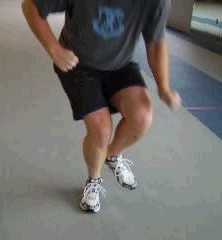Ankle Dorsiflexion:
As we have discussed, there is a ripple effect up the entire kinetic chain. A dorsiflexion restriction is very evident in squatting patterns. The Squat is likely the most fundamental movement pattern for all athletics, and for life in general. If we can’t squat in functional manner, we will struggle to sit in a chair, much less stand in an athletic ready stance.
Poor Ankle Dorsiflexion has huge impact on an athlete’s ability to squat. Poor dorsiflexion will limit an athlete’s ability to get in a good, deep squat. Squatting below parallel is important for several reasons:
- Limiting an athlete’s range of motion during lifting movements will eventually cause a functional mobility deficit. Meaning, if you always train in a limited range of motion, at some point the body will remember the limited range of motion and only work in the limited range that it has trained in, thus decreasing overall function.
- If an athlete never reaches parallel during a squat, their glutes never activate. The glutes are likely the most powerful muscle in the lower body. Limiting their ability to activate during a workout is simply doing that athlete an injustice with their overall athletic development.
Poor dorsiflexion will affect the squat in 1 of 3 ways. As we have said, it will limit the athlete’s ability to effectively squat deeply, so an athlete will find another way to get the job done. Remember that the body will aways find the path of least resistance. Meaning, the body will always sacrifice quality of motion for quantity of motion. So, if you ask an athlete to squat lower (quantity of motion), it will find the easiest path to get lower, even if it is a poor quality squat.
The 3 most common compensation patterns for a dorsiflexion restriction are:
- Coming up onto the toes at the bottom of the squat – This can be dangerous during a squat, especially if the athlete is squatting heavy weight. If they raise up onto their toes, they have a very unstable platform from which to drive through and they will likely loose their balance, putting themselves and/or a spotter at risk for injury with heavy weights.
- Flexing at the waist – As an athlete attempts to gain more motion, they will hit the bottom of their squat as dictated by their restriction and they will attempt to gain more motion by leaning forward at the waist. This is obviously dangerous because it exposes the athlete to a lumbar spinal injury.
 Over pronation and knee valgus – The final typical compensatory pattern seen with a dorsiflexion restriction is a combination of poor patterns at the foot, ankle, knee and hip joints. As the athlete approaches their restriction, they will over pronate and flatten out their foot to get around their restriction. As they pronate, that will force their knee into a valgus position to continue to gain extra depth and range of motion. This is a poor position to strengthen due to it’s relation to ACL injuries and patellofemoral pain.
Over pronation and knee valgus – The final typical compensatory pattern seen with a dorsiflexion restriction is a combination of poor patterns at the foot, ankle, knee and hip joints. As the athlete approaches their restriction, they will over pronate and flatten out their foot to get around their restriction. As they pronate, that will force their knee into a valgus position to continue to gain extra depth and range of motion. This is a poor position to strengthen due to it’s relation to ACL injuries and patellofemoral pain.
When an athlete can’t perform a deep, clean squat, most people just assume it is because their hips are too tight. The reality is, it usually has little to do with their hips, it’s their ankles.
Back to Ankle DorsiflexionBack to Injury Rehabilitation
Back to Home


Leave a Reply